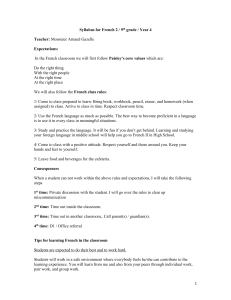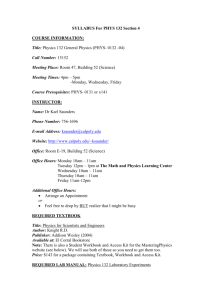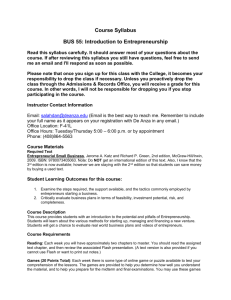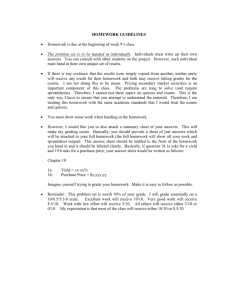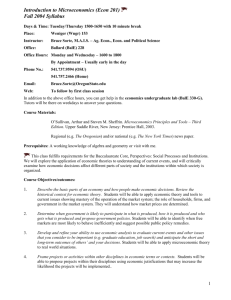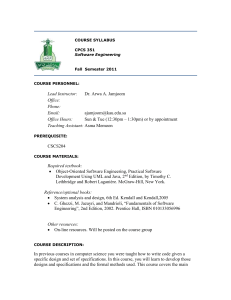Syllabus for Section 1
advertisement
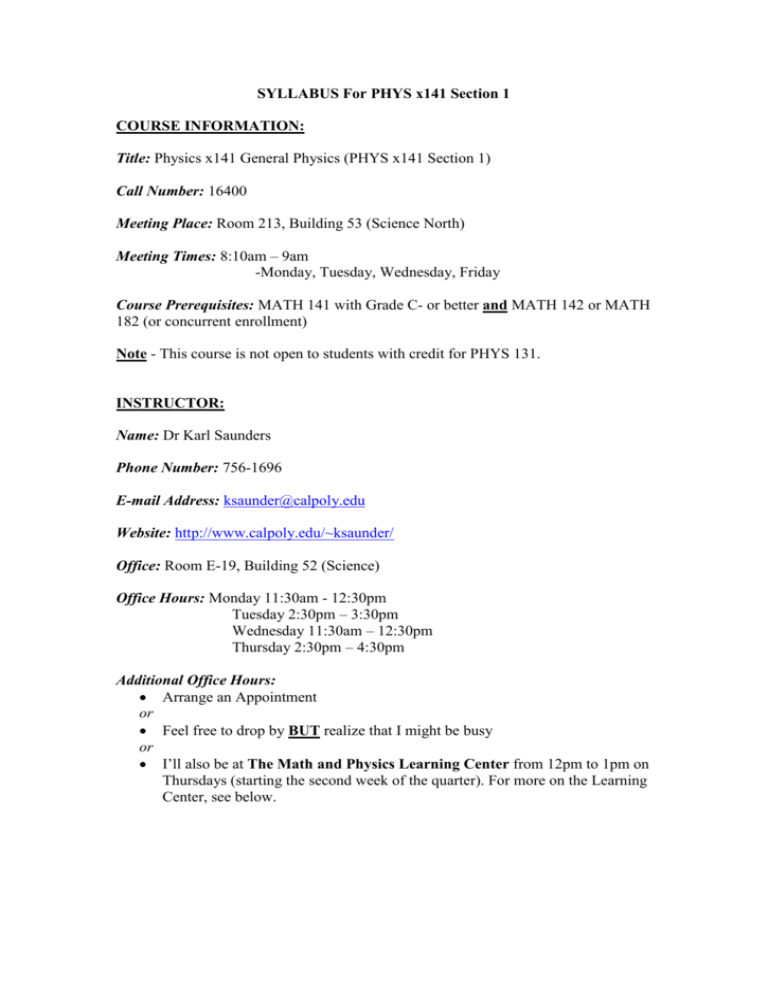
SYLLABUS For PHYS x141 Section 1 COURSE INFORMATION: Title: Physics x141 General Physics (PHYS x141 Section 1) Call Number: 16400 Meeting Place: Room 213, Building 53 (Science North) Meeting Times: 8:10am – 9am -Monday, Tuesday, Wednesday, Friday Course Prerequisites: MATH 141 with Grade C- or better and MATH 142 or MATH 182 (or concurrent enrollment) Note - This course is not open to students with credit for PHYS 131. INSTRUCTOR: Name: Dr Karl Saunders Phone Number: 756-1696 E-mail Address: ksaunder@calpoly.edu Website: http://www.calpoly.edu/~ksaunder/ Office: Room E-19, Building 52 (Science) Office Hours: Monday 11:30am - 12:30pm Tuesday 2:30pm – 3:30pm Wednesday 11:30am – 12:30pm Thursday 2:30pm – 4:30pm Additional Office Hours: Arrange an Appointment or Feel free to drop by BUT realize that I might be busy or I’ll also be at The Math and Physics Learning Center from 12pm to 1pm on Thursdays (starting the second week of the quarter). For more on the Learning Center, see below. REQUIRED TEXTBOOK Title: Physics for Scientists and Engineers Author: Knight R.D. Publisher: Addison Wesley (2004) Available at: El Corral Bookstore Note: There is also a Student Workbook and Access Kit for the MasteringPhysics website (see below). We will use both of these so you need to get them too. Price: $143 for a package containing Textbook, Workbook and Access Kit. Supplemental (not required) Text: There is also a booklet called Supplemental Notes and Problems that was put together by Professor Ronald Brown (one of the physics faculty here). It looks at the same material we are covering but in a different way. It can be good to look at physics (and anything else!) from different perspectives so this might be useful to you. It should be available at the bookstore for $7.25. RESOURCES The Math and Physics Learning Center: If you are having trouble with the homework or understanding the concepts, the physics learning center will be open 25 hours a week. It is located in Room A03 in Building 52 (Science). A math professor, a math student, a physics professor, and a physics student staff the learning center. The hours are Monday to Friday 9am - 2pm, starting the second week of each quarter. Web Resources: My Personal Website http://www.calpoly.edu/~ksaunder/ This website contains a link to my Phys x141 website that will include the syllabus, class notes, homework assignments and solutions as well as announcements, including exam times MasteringPhysics Website: http://www.masteringphysics.com This is an online tutorial and homework and system run by the publisher of our textbook. You can access it using the Access Kit that came with your book- there is an Access Code on the inside cover of the kit. The kit also contains a Getting Started booklet that you should read. I am also giving you a handout called “Using MasteringPhysics” that contains useful information, including how to register the first time. We will be using this website for doing homework so get comfortable with it as soon as possible. COURSE FORMAT: I will lecture using PowerPoint and the blackboard. I will use PowerPoint to present the basic ideas that make up the backbone of each class. We will then explain, expand and discuss these ideas, often using the blackboard. I will post the PowerPoint slides online on my personal website (see above) in advance. These will not constitute a full set of notes. I suggest printing them out in advance of class and then adding to them during class. There will also be discussion and we will work together on problems and exercises from the student workbook so bring paper, pen/pencil, calculator and the student workbook. I will assign reading from the textbook in advance of each class In the calendar below I list the chapters I plan to cover each week. At the end of each class I will tell you what I plan to cover the next day so you can read in advance. This is important as I will generally assume that you have read (in advance) the material I am going to cover each day Classroom behavior: We should all expect behavior in the classroom that is considerate of everyone else in the classroom. This covers a lot of different things but includes not eating/ drinking or reading the newspaper. It also means we (including me) should turn our cell phones off. If you need to take a call then leave the classroom and don’t come back until the next time we meet. If people are getting up and coming back in it is distracting for us all. Attendance: It is very important to attend every class – the quarter system moves quickly. Part of not falling behind means attending all the classes, so I am going to award extra credit (5%) for attendance. If you miss no more than 2 classes you will receive all the extra credit. If you miss only three classes you’ll receive half the extra credit and if you miss only four classes you’ll receive a quarter of the extra credit. If you miss more than four classes then you’ll receive no extra credit- in fact I’ll probably be quite worried about you. There are no excused absences (unless exceptional) so save the two allowed absences for unexpected difficulties such as when you feel too sick to attend class, or for out of town athletic events you participate in, etc. HOMEWORK Working on homework is an absolutely crucial aspect of this course. It will test to see if you understand the material presented and, equally importantly, it will help you to develop the skills of model building, critical thinking and problem solving. The exams I give will contain questions similar to those you receive for homework so it is also in your interest to work hard on the homework if you want to do well on the exams. I may even use some of the homework problems for exam problems! A (tentative, i.e., subject to change) list of the homework problems that I will give each week is given in the schedule. At the end of each class I will assign you the homework problems you should be ready to tackle. At the same time I will also announce the due date for this homework. In all cases late homework will not be accepted. The solutions will be posted online on my personal website (see above). You will complete each problem in one of two ways (I will tell you which way for each problem). They are: WAY 1: Handwritten and turned in to me. Put only one problem per page. Clearly label the problem number, date and your collaborators (see below) at the beginning of each problem. Keep all of your homework together and organized - use a ring binder. This will help you when you are studying for exams. If you come to my office with a question on a homework problem bring the binder with you so I can see your approach to the problem. WAY 2: Using the Mastering Physics (MP) Website (see above) You’ll log on to the MP website using your login and password. Here you’ll see a list of the problems I want you to do. The deadline will appear at the top of the screen. The computer has no mercy with regard to the deadline. It stops giving credit at exactly this time. However, you can continue to submit answers for partial credit that steadily decreases to zero during the next 24 hours after a deadline. We will start by mainly using WAY 1 and as the quarter progresses we will gradually use WAY 2 more and more. Eventually we will use WAY 2 for all the problems except for a couple that I’ll ask you to turn each week in using WAY 1 so I can see how you worked them out. Don’t wait long to figure out how to use WAY 2!!! It’s best that you get comfortable early on or else you’ll have trouble later on. Also- a lot of other Instructors use the Mastering Physics website and you may have one of them next quarter, so it is good to become comfortable with it now. Collaboration: You can work on problems (or study) individually or in groups. Collaboration is an important aspect of everyday life and develops teamwork and communication skills. You are to name your collaborators at the start of each homework problem. A few words of advice, however: It is a good idea to think about the problem by yourself first. You may find that for a particular problem collaboration isn’t necessary. If collaboration is necessary then you will make it more productive by knowing what you do and don’t understand about the problem before collaborating. If you collaborate on and solve a problem you must make sure that you, individually, understand how the solution is reached. A good way to check this is to try the problem again by yourself and without looking at the solution. The quizzes and exams will consist of problems similar to those from homework. It is better to make sure you understood the solution while doing homework than to realize you didn’t during the exam! If you are having difficulty with the homework (or other) problems you can bring your question to: Class My office The Physics Learning Center (see above) A classmate Student Workbook: There is a Student Workbook in addition to the Textbook. It consists of short exercises that are nearly all qualitative rather than quantitative. They don’t involve significant calculation and are basically there to give you a chance to practice the ideas and techniques that you’ll learn from the textbook and class. I’ll assign some exercise to you each day and we’ll also work on exercises during class. I’ll use some of the exercises I assign in the quiz. “Study: 25-35 Hours/Week”: You have all seen the “Study 25-35 Hours/Week – 2 hours /unit/week” signs around campus. This class is four units so you should be studying at least 8 hours for it. “Studying” includes (but is not limited to): Reading Doing exercises from the workbook Doing the homework problems Preparing for quizzes and exams THINKING about the concepts Studying isn’t just reading and memorizing. If it was, there is no way I could study 25-35 hours a week. The great thing about taking a physics class is that a lot of the “study” is problem solving. You learn a lot of the physics through being challenged by problems, not just reading the textbook. It’s kind of like learning vocabulary by doing crosswords instead of just reading a dictionary - which sounds more fun to you? Studying 8 hours a week (at least) for this course may seem a lot but remember that the studying takes many forms and you’ll be surprised how quickly time will fly when working on problems. QUIZZES There will be occasional announced quizzes. There may also be occasional take home problems that will count as quizzes. These must be done independently (i.e. no collaboration) and turned in when due. The quizzes will often contain questions that are very similar to the exercises from the Student Workbook (see above). EXAMS There will be two midterm exams and a final exam. The exams will include both problems to set up and/or solve and conceptual questions in the material. The dates are given in the schedule. They are: Midterm 1: In class Monday October 18th Midterm 2: In class Monday November 15th Final Exam: Tentative Date is Tuesday December 7th 7:10pm- 10pm. Location to be announced. This is a common final for all of the sections of Phys x141 that I’ll be teaching. The final exam is comprehensive. If you fail the final you will fail the course. If you have to miss an exam, then arrangements must be made before the exam is given. If there is a test day emergency or illness, then leave me a message at my office (7561696) BEFORE THE TEST. Then make arrangements with me as soon as possible. PARTICIPATION It is very important that you are active in the course beyond doing homework, exams and being a warm body in a desk. The best way to do this is to ASK QUESTIONS. It makes the class more interesting, engaging and fun for me and- more importantlyyou! You can ask questions or make a comment: If there is something you don’t understand Something I didn’t explain well If you notice something interesting If you think I made a mistake (I guarantee I will at some stage) If you want to catch me out If you want me to hear a voice other than mine ANYTHING ELSE (!!!) relevant to the class There are ways to participate beyond the classroom. You can come by my office for a chat about something you don’t understand, something I didn’t explain well, something you find interesting or anything else. You can email me too. Basically I want you to interact with me. This will help me get a sense of how you are doing and how I am doing. Learning isn’t just about one person shoveling information to the other. It is more rewarding when it is an interactive process and a two way street. A participation grade will make up 5% of your final mark GRADING Participation: 5% Homework: 15% Quizzes: 10% Midterm 1: 20% Midterm 2: 20% Final: 30% Extra Credit for Attendance: 5% WHAT ARE WE GOING TO LEARN ABOUT? Motion 1. How to describe and analyze different types of motion 2. Forces acting on object- what happens to the object? 3. Energy, Momentum and Conservation Laws 4. Important Applications- Rotation of Rigid Bodies 1. Concepts that describe motion Position Velocity Acceleration What do these words mean exactly and how do we use them? Ways to analyze motion: Words Pictures Graphs Mathematics 2. Causes of motion: Explaining why an object moves (or doesn’t) the way it does Force and Newton’s three laws 3. Other concepts associated with motion Momentum and Impulse- used for describing collisions between objects Energy- Kinetic and Potential. How is one type converted into the other? Why do objects released from a greater height or from a more tightly coiled spring move faster? Conservation Laws for Energy and Momentum. Work- Transferring energy to a system using force. 4. Rotation of a Rigid Body- Torque, Static Equilibrium Along the way we are also going to learn important skills and gain valuable experience (for physics and beyond). Model Building Critical Thinking Problem Solving Model Building If we want to analyze a complicated situation (reality is complicated!) what do we do? - Simplify the situation – how much? - Isolate the essential features- what are these? The “how much?” and “what are these?” involve Critical Thinking Problem Solving If we want to predict an outcome from the complicated situation what do we do? - Build a Model - Using rules (e.g. laws of physics) for the model solve (e.g. mathematically) to find the outcome COURSE OBJECTIVES By the end of the quarter you should know how to: Describe an object’s motion using words, pictures, graphs and mathematics Explain an object’s motion- why it is doing what it is doing Build models to analyze the motion of objects Solve problems using the models you build

